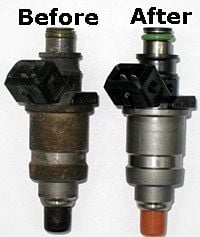The Main Principles Of Best Injector Cleaner
Table of ContentsBest Injector Cleaner Things To Know Before You BuyThe Best Injector Cleaner StatementsBest Injector Cleaner Can Be Fun For Everyone
A cutaway model of a petrol direct injected engine Fuel injection is the introduction of fuel in an internal combustion engine, many typically vehicle engines, by the methods of an injector. This short article focuses on fuel injection in reciprocating piston and rotary piston engines. All Diesel (compression-ignition) engines usage fuel injection, and many Otto (spark-ignition) engines use fuel injection of one kind or another.
Typically, the only thing in typical all fuel injection systems have is the lack of carburetion. There are 2 main functional concepts of mix development systems for internal combustion engines: internal mixture formation, and external mix development. A fuel injection system that uses external mix formation is called a manifold injection system; there exist two kinds of manifold injection systems: multi-point injection (port injection), and single-point injection (throttle-body injection).
There exist a number of different ranges of both direct and indirect injection systems, the most common internal mixture formation fuel injection system is the common-rail injection system, a direct injection system. best injector cleaner. The term electronic fuel injection refers to any fuel injection system having an engine control unit. A perfect fuel injection system can precisely offer exactly the best amount of fuel under a all engine operating conditions.
In practice a perfect fuel injection system does not exist, but there is a big range of various fuel injection systems with certain advantages and disdvantages. The majority of these systems were rendered outdated by the common-rail direct injection system that is nowadays (2020) utilized in numerous passenger cars. Common-rail injection permits fuel direct injection, and is even better fit for diesel motor fuel direct injection - best injector cleaner.
When creating a fuel injection system, a variety of factors has actually to be taken into account, including: All fuel injection systems consist of 3 basic components: they have at least one fuel injector (in some cases called an injection valve), a device that develops enough injection pressure, and a gadget that meters the correct amount of fuel.
Our Best Injector Cleaner Ideas

Early mechanical injection systems (other than air-blast injection) typically utilized injection valves (with needle nozzles) in combination with a fairly advanced helix-controlled injection pump that both metered the fuel, and developed the injection pressure. They were appropriate for periodically injecting multi-point injection systems along with all sorts of conventional direct injection systems, and chamber-injected systems.
In modern engines, the fuel metering and injection valve actuation is generally done by the engine control system (best injector cleaner). For that reason, the fuel injection pump does not have to meter the fuel or actuate the injection valves; it only needs to supply injection pressure. These modern-day systems are used in multi-point-injected engines, and common-rail-injected engines.
The summary below illustrates the most common types of mixture formation systems in internal combustion engines. There are several different methods of characterising, grouping and describing fuel injection systems, the clade is based upon a differentiation between internal and other external mixture development systems. Mix development systems Internal mix formation Indirect injection Direct injection Hydraulic injection Walldistributed injection Airdistributed injection Pumpe-Dse system Pump-rail-nozzle system Air-guided injection Wall-guided injection Spray-guided injection Conventional helixcontrolled injection pump systems Lanova direct injection Afterchamber injection G-System (sphere combustion chamber) Gardner system (hemisphere combustion chamber) Saurer system (torus combustion chamber) Flat piston (combustion chamber in between piston and head) External mix development Constant vacuum carburettor Multistage carburettor Multi-barrel carburettor Float-chamber-less membrane carburettor BMW M88 engine with multi-point injection In an engine with external mixture development, air and fuel are combined outside the combustion chamber, so that a premixed mixture of air and fuel is sucked into the engine.
There exist 2 main external mix development systems in internal combustion engines: carburettors, and manifold injection. The following description focuses on the latter. Manifold injection systems can also be thought about indirect injection, however this post primarily utilizes the term indirect injection to explain internal mixture formation systems that are not direct injection.
They can use numerous various injection plans. Single-point injection utilizes one injector in a throttle body mounted likewise to a carburetor on an consumption manifold. As in a carbureted induction system, the fuel is blended with the air prior to the inlet of the intake manifold. Single-point injection was a reasonably affordable way for car manufacturers to lower exhaust emissions to abide by tightening up guidelines while providing much better "driveability" (easy beginning, smooth running, freedom from doubt) than might click over here be obtained with a carburetor.
This postponed the redesign and tooling expenses of these parts. Single-point injection was used thoroughly on American-made passenger cars and trucks and light trucks throughout 19801995, and in some European automobiles in the early and Read Full Report mid-1990s. Multi-point injection injects fuel into the consumption ports simply upstream of each cylinder's consumption valve, rather than at a central point within an intake manifold.
The Definitive Guide to Best Injector Cleaner
Manifold injected engines can use a number of injection plans: constant, and intermittent (simultaneous, batched, sequential, and cylinder-individual). In a continuous injection system, fuel streams at all times from the fuel injectors, however at a variable circulation rate. The most common automotive continuous injection system is the Bosch K-Jetronic, presented in 1974, and utilized until the mid-1990s by various automobile makers.
In an engine with an internal mix development system, air and fuel are mixed just inside the combustion chamber. Therefore, just air is drawn into the engine throughout the consumption stroke. The injection scheme is constantly intermittent (either sequential or cylinder-individual). There are two different kinds of internal mixture formation systems: indirect injection, and direct injection.